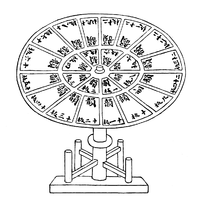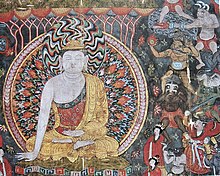The following is a list of the Four Great Inventions of ancient China—as designated by Joseph Needham (1900–1995), a sinologist known for his research on the history of Chinese science—in the chronological order that they were established in China.
Paper
- This sub-section is about papermaking; for the writing material first used in ancient Egypt, see papyrus.
Although it is recorded that the Han Dynasty (202 BC–AD 220) court eunuch Cai Lun (b.c.50–AD 121) invented the pulp papermaking process and established the use of new raw materials used in making paper, ancient padding and wrapping paper artifacts dating to the 2nd century BC have been found in China, the oldest example of pulp papermaking being a map from Fangmatan, Tianshui;[8] by the 3rd century, paper as a writing medium was in widespread use, replacing traditional but more expensive writing mediums such as strips of bamboo rolled into threaded scrolls, and strips of silk, wet clay tablets hardened later in a furnace, and wooden tablets.[9][10][11][12][13]The earliest known piece of paper with writing on it was discovered in the ruins of a Chinese watchtower at Tsakhortei, Alxa League, where Han Dynasty troops had deserted their position in AD 110 following a Xiongnu attack.[14] In the papermaking process established by Cai in 105, a boiled mixture of mulberry tree bark, hemp, old linens, and fish nets created a pulp that was pounded into paste and stirred with water; a wooden frame sieve with a mat of sewn reeds was then dunked into the mixture, which was then shaken and then dried into sheets of paper that were bleached under the exposure of sunlight; K.S. Tom says this process was gradually improved through leaching, polishing and glazing to produce a smooth, strong paper.[11][12]
Printing
Woodblock printing: The earliest specimen of woodblock printing is a single-sheet dharani sutra in Sanskrit that was printed on hemp paper between 650 and 670 AD; it was unearthed in 1974 from a Tang tomb near Xi'an.[15] A Korean miniature dharani Buddhist sutra discovered in 1966, bearing extinct Chinese writing characters used only during the reign of China's only self-ruling empress, Wu Zetian (r.690–705), is dated no earlier than 704 and preserved in a Silla Korean temple stupa built in 751.[16]The first printed periodical, the Kaiyuan Za Bao was made available in AD 713. However, the earliest known book printed at regular size is the Diamond Sutra made during the Tang Dynasty (618–907), a 5.18 m (17 ft) long scroll which bears the date 868 AD, or the "fifteenth day of the fourth moon of the ninth year" of Emperor Yizong's (859–873) Xiantong 咸通 reign period.[17] Joseph Needham and Tsien Tsuen-Hsuin write that the cutting and printing techniques used for the delicate calligraphy of the Diamond Sutra book are much more advanced and refined than the miniature dharani sutra printed earlier.[17] The two oldest printed Chinese calendars are dated 877 and 882; they were found at the Buddhist pilgrimage site of Dunhuang; Patricia Ebrey writes that it is no surprise that some of the earliest printed items were calendars, since the Chinese found it necessary to calculate and mark which days were auspicious and which were not.[17][18]
Movable type: The polymath scientist and official Shen Kuo (1031–1095) of the Song Dynasty (960–1279) was the first to describe the process of movable type printing in his Dream Pool Essays of 1088, attributing this innovation to a little-known artisan named Bi Sheng (990–1051).[19][20][21][22] With the use of fired clay characters, Shen described Bi's technical process of making the type, type-setting, printing, and breaking up the type for further use.[22][23] Bi had experimented with wooden type characters, but their use was not perfected until 1297 to 1298 with the model of the official Wang Zhen (fl. 1290–1333) of the Yuan Dynasty(1271–1368), who also arranged written characters by rhyme scheme on the surface of round table compartments.[20][24] It was not until 1490 with the printed works of Hua Sui (1439–1513) of the Ming Dynasty (1368–1644) that the Chinese perfected metal movable type characters, namely bronze.[25][26] The Qing Dynasty (1644–1912) scholar Xu Zhiding of Tai'an, Shandong developed vitreous enamel movable type printing in 1718.[27]
Effects on bookbinding: The advent of printing in the 9th century revolutionized bookbinding. Late Tang Dynasty paper books evolved from rolled scrolls of paper into folded leaves like a pamphlet, which developed further in the Song Dynasty (960–1279) into 'butterfly' bindings with leaves of paper folded down the center like a common book. During the Yuan Dynasty (1271–1368) wrapped back bindings had two edges of the leaves attached to the spine and secured with a stiff paper cover on the back. Books of the Ming Dynasty (1368–1644) had a thread-stitched binding in the back.[28] It was not until the early 20th century that traditional Chinese thread-stitched bookbinding was replaced byWestern-style bookbinding, a parallel to the replacement of traditional Chinese print methods with the modern printing press, in the tradition of Johannes Gutenberg (c. 1400–1468).[29]
Gunpowder
Evidence of gunpowder's first use in China comes from the Five Dynasties and Ten Kingdoms Period (618–907).[30] The earliest known recorded recipes for gunpowder were written by Zeng Gongliang, Ding Du, and Yang Weide in the Wujing Zongyao, a military manuscript compiled in 1044 during the Song Dynasty (960–1279). Its gunpowder formulas describe the use of incendiary bombs lobbed from catapults, thrown down from defensive walls, or lowered down the wall by use of iron chains operated by a swape lever.[31][32][33] Bombs launched from trebuchet catapults mounted on forecastles of naval ships ensured the victory of Song over Jin forces at the Battle of Caishi in 1161, while the Mongol Yuan Dynasty (1271–1368) used gunpowder bombs during their failed invasion of Japan in 1274 and 1281.[32] During the 13th and 14th centuries, gunpowder formulas became more potent (with nitrate levels of up to 91%) and gunpowder weaponry more advanced and deadly, as evidenced in the Ming Dynasty (1368–1644) military manuscript Huolongjing compiled by Jiao Yu (fl. 14th to early 15th century) and Liu Ji (1311–1375). It was completed in 1412, before Liu's death, with a preface added by the Jiao in its Nanyang publication.[34]
Compass
Although an ancient hematite artifact from the Olmec era in Mexico dating roughly 1000 BC indicates the possible use of the lodestone compass long before it was described in China, the Olmecs did not have iron which the Chinese would discover could be magnetized by contact with lodestone.[36] Descriptions of lodestone attracting iron were made in the Guanzi, Master Lu's Spring and Autumn Annals and Huainanzi.[37][38][39] The Chinese by the Han Dynasty (202 BC–220 AD) began using north-south oriented lodestone ladle-and-bowl shaped compasses for divination and geomancy and not yet for navigation.[40][41][42]The Lunheng, written by Wang Chong (27–c. 100 AD) stated in chapter 52: "This instrument resembles a spoon, and when it is placed on a plate on the ground, the handle points to the south".[43][44] There are, however, another two references under chapter 47 of the same text to the attractive power of a magnet according to Needham (1986),[45] but Li Shu-hua (1954) considers it to be lodestone, and states that there is no explicit mention of a magnet inLunheng.[35] Shen Kuo (1031–1095) of the Song Dynasty (960–1279) was the first to accurately describe both magnetic declination (in discerning true north) and the magnetic needle compass in his Dream Pool Essays of 1088, while the author Zhu Yu (fl. 12th century) was the first to mention use of the compass specifically for navigation at sea in his book published in 1119.[21][41][46][47][48][49][50] Even before this, however, the Wujing Zongyao military manuscript compiled by 1044 described a thermoremanence compass of heated iron or steel shaped as a fish and placed in a bowl of water which produced a weak magnetic force via remanence and induction; the Wujing Zongyao recorded that it was used as a pathfinder along with the mechanical South Pointing Chariot.[51][52][53]







